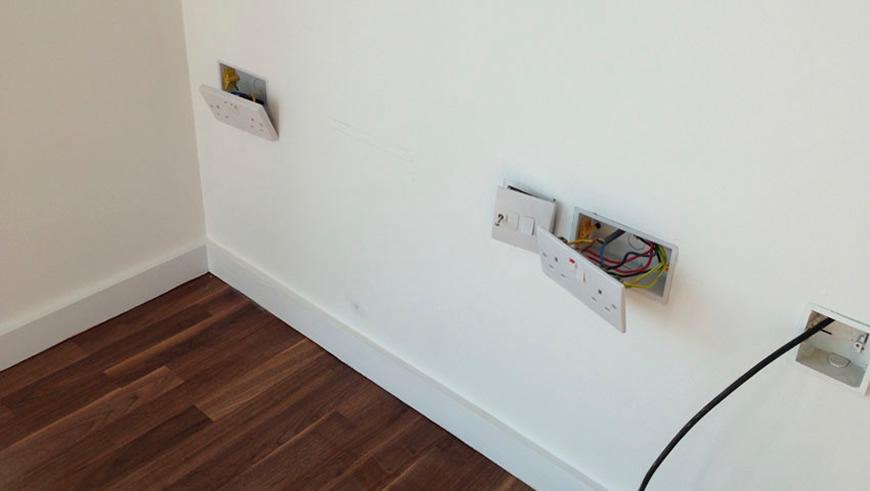Cost of Moving a Light Switch
Last updated 10th June, 2025
Have you been thinking about changing a light switch?
If you want to relocate a light switch or socket and want to know the costs involved then this guide is for you! We cover light switch fittings, switch prices and moving sockets. So for a comprehensive breakdown of the supply costs, labour fees and timeframes stay on this page!
Let's get started below!

Table of Contents
- How much does moving a light switch or socket outlet cost?
- What's involved when moving a light switch or socket?
- What impacts how much moving a light switch or socket costs?
- Installing smart switches and sockets
- Moving a light switch/socket DIY vs professional
- Are there any building regulations
- FAQs
How Much Does Moving a Light Switch or Socket Outlet Cost?
The average cost to move a single light switch or socket is typically around £100-£150 including materials. It's usually a straightforward job that won't take more than a couple of hours for an experienced electrician to complete.
Electricians will often work in pairs for safety reasons but will also work in pairs simply if the job will take one man for more than a couple of days to complete. As such you should expect a labour cost of around £150 per day for one electrician or £250 per day for two. As most electricians charge for a minimum of half a day's work it's not economical to have them change just one switch/socket, so if you're planning on making more changes in the future it makes sense to get them all done at once as this will massively reduce the cost per switch/socket.
Below are some estimated costs of hiring an electrician to move, replace or install a light switch or socket. These prices include materials and a quick plaster repair job where required. As you can see, when getting multiple sockets/switches moved or replaced it works out much cheaper per fixture.
| Job Description | Avg. Cost | Duration |
|---|---|---|
| Move Light Switch or Socket | £150 | 3-4 hours |
| Replace like-for-like a Switch or Socket | £75 | 1 hour |
| Install Additional Switch or Socket | £150 | 2-3 hours |
| Replace 5 like-for-like Switches or Sockets | £100 | 2-3 hours |
| Install 5 Additional Switches or Sockets | £250 | 1 day |
Cost Breakdown Calculator
Individual costs for hiring a sparky to move a light switch or socket - Total Cost: £150
Materials
£15
Tradesmen
£135
Waste Removal
£0
What's Involved When Moving A Light Switch or Socket?
Moving a light switch and/or power socket is something that any of us consider from time to time. Although the socket/switch position was (hopefully) initially set up to be suitable for a wide range of furniture arrangements and lifestyles, things have changed a lot in recent years.
Plus of course, a lot of people change the layout of their homes by knocking through internal walls or building extensions, so the old power sockets and light switches no longer work for the new layout.
What do I need to consider?
If you are looking to move a light switch or socket, then there are a few things to considerwhen getting a quote. For example, check if the prices include any decorating/plastering required, if all materials are included, and that installing and checking junction boxes will be done as per current regulations. The days of joining a cable to the old light switch and then plastering over it are long gone.
If you do this, then your house insurance could be invalidated and it could also cause problems if noticed when selling your home in the future. When installing a light switch today you must have a junction box, which can be placed at floor level fixed to the skirting or under the floor boards.
Either way it has to be accessible which adds to the overall costs. The alternative is to strip the cable out all the way to the previous junction box, but that would cost even more as it would take longer and bump up the labour costs.
Most electricians will arrange for a plasterer to come in and repair the walls after installing a new socket or switch, but do not assume this, always check. Once the plastering work is done the electrician will then finish off the sockets and/or light switches.
What Impacts How Much Moving a Light Switch or Socket Costs?
If you are planning to rewire an entire house, this has the potential to cost anywhere between £1,500 and £6,000 so simply moving a light switch/socket if needed is a much cheaper option. However, there are still other factors to consider as follows.
- Location of property - Electrician prices can vary, especially depending where you are in the UK. For example London tends to be substantially higher than the North due to overheads and the cost of living.
- Distance of move - Depending how far you're moving a light switch/socket can determine how long the job will take, which can understandably influence the end cost.
- How many switches/sockets - If you're moving several at once, it may be more expensive but can prove cost-effective in the long run, especially if any are only being moved a short distance.
- Type of fitting - Chrome switches and sockets are more expensive than regular plastic casing, as too are modern options such as smart switches or designer lighting.
- Electrical meter - If you need to relocate your electrical meter (£300 to £600) or move a junction board this will also increase cost substantially.
- Various wall types - This can potentially affect the cost, as for example a solid wall is harder to relocate a switch/socket than a wall made from plasterboard.
- Plastering/Painting - While the cost of any touch ups may be included in the quote, this is not always the case and you could need to hire someone to replaster the walls or a painter/decorator where necessary.
Installing Smart Switches and Sockets
If you're already planning to move a light switch/socket then it's good opportunity for an upgrade. The installation of Smart switches are becoming increasingly popular, allowing the user to control their lighting remotely via an app or voice assistant like Alexa or Google Home.
The cost of Smart switches are around £25 to £60 each, and electricians can usually install them within the cost of their normal hourly rate (although it's always best to double check first).
Pros
- ✔ Convenient with remote control via app or voice control.
- ✔ Automated devices and timers can help improve energy efficiency
- ✔ Being able to control remotely adds another layer to home security
Cons
- ✖ More expensive than standard light switches/sockets
- ✖ Some models may require a neutral wire to be connected
- ✖ May need installing via an app or a regular Wi-Fi connection
Moving a Light Switch/Socket DIY vs Professional
Technically, in most instances, you could do this job yourself as a DIY project if you are confident you can do the work safely, but it is not recommended and ideally you should hire a professional electrician.
Each year on average in the UK there are over 12,000 fires caused by faulty electrical work or deteriorating electrical installations!
If you do have the DIY capability or experience of moving a light switch/socket, then it's worth reminding yourself of the following:
- Check local codes and practices, some instances may require a qualified electrician.
- Always turn off the electricity at the breaker box before starting.
- Ensure to use a voltage tester to confirm the circuit is off.
- Basic wiring - ie live (usually brown or red), neutral (blue or black), and earth/ground (green/yellow).
- Have the correct tools and material to complete the job.
- Test the circuit once completed before using.
DIY Moving a Light Switch/Socket
Pros
- ✔ Tailor your light switch/sockets to your needs
- ✔ More convenient when only moving a short distance
- ✔ Save labour costs on electrician fees
Cons
- ✖ Risk of an electric shock if safety precautions aren't followed
- ✖ Can create short circuit or hazards if not actioned correctly
- ✖ Potential to not be officially covered by home insurance
Professional Moving a Light Switch/Socket
Pros
- ✔ Ensures any electrical codes and regulations are followed correctly
- ✔ Work is often guaranteed, and any accidental damages covered.
- ✔ Faster, more efficient and peace of mind work is done correctly
Cons
- ✖ Can become an expensive job if a lot of rewiring is involved
- ✖ There may be a minimal charge when only moving a short distance
- ✖ Need to plan in advance and schedule an appointment
In conclusion, while you can do so yourself, the cost of moving a light switch and socket by a qualified electrician definitely outweighs the risks of doing it by yourself. It's less likely to cause issues further down the road, and you have the peace of mind it's been done properly to start with.
Are There Any Building Regulations
Moving a light switch or socket is not normally considered work under Building Regulations, Part P - as long as it is not in a kitchen or special location (such as a bathroom), but there are exclusions and special circumstances, if in any doubt whatsoever, check with your local Building Control department. But technically, in most instances, you could do this job yourself as a DIY project if you are confident you can do the work safely, but it is not recommended.
All electrical work should follow the safety standards in BS 7671 no matter who does the work. The Building Regulations do not restrict who may carry out electrical work, but for all work classed as notifiable under The Building Regulations, it needs to be checked to make sure that it is safe by using an electrician registered with a competent person scheme or by submitting a Building Regulation application to the local building control.
A "Competent Person" is an electrician who is registered by an organisation authorised by the Secretary of State and is able to certify electrical work as is safe without notifying Building Control. The electrician will arrange for you to get a building regulations compliance certificate after the completion of the work and the local authority will also be notified about the work for their own records.
FAQs
It's easy to make an electrical socket or light switch work, anyone can do that - but it's far more difficult to make the circuit work safely! It is advisable to ask any electrician you are considering hiring to provide information about which scheme they belong to and their membership number. You can then check directly with that organisation to make sure they are in fact registered. The organisations which are authorised run the government competent person schemes for electrical installation work are BRE Certification Ltd, BSI (British Standards Institution), ELECSA Ltd, NAPIT Certification Limited, NICEIC Certification Services Ltd, CORGI and OFTEC.
You should of course also check references from previous customers and compare several quotes before making a decision to let someone come in and work in your home, especially on something as potentially dangerous as the electrical supply. So make sure your electrician is registered, agree a contract with them for the work you require - and stay safe!










